Immerse yourself in Barcelona's vibrant flavors and uncover hidden culinary gems with our expert insider guides. Plan an unforgettable trip today!
Read more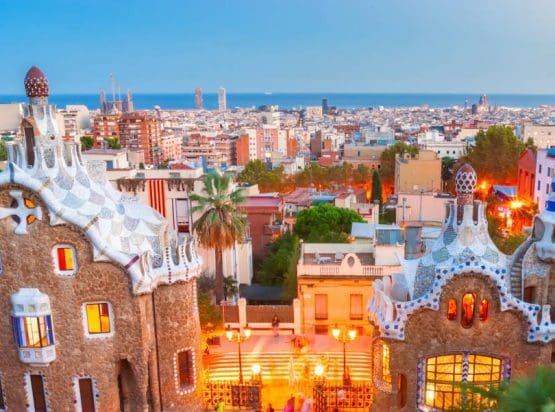
EXPLORE ALL OUR CATALUNYA WINE REGIONS GUIDE
Last updated: October 5, 2024
Spain’s traditional method sparkling is getting better and better: a renewed emphasis on site selection has reinvigorated this once-ailing DO. And although producers get fidgety if you suggest the past was less than glorious, the fact remains that Cava had a formidable mountain to climb. After selling itself as the ‘cheap option,’ wineries like Gramona found it difficult to charge premium prices for a high-quality product that wasn’t Champagne. Debates surrounding greater segmentation and zoning fell on deaf ears; over 12 leading bodegas have left the appellation since 2012, including Raventos I Blanc and Recaredo. As it stands today, their owners are not in a rush to return.
Yet there is much to admire in 21st-century Cava. The remaining producers are united under a quality banner, exporting a growing range of styles, including aromatic rosé, 100% Chardonnay wines, and single-vineyard expressions of Xarel-lo. There are some deluxe cuvées to tempt you away from France’s top dog and plenty of very affordable – and delicious – bubbly to crack open tonight. There is no reason for this Spanish powerhouse to play second fiddle to Champagne. Witness the rebirth.
Discover more about Spanish Wine
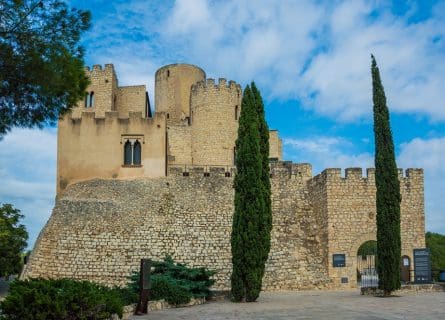
Catalunya’s history is endlessly fascinating: ancient tribes intermingled with Phoenician and Greek traders, who are believed to have planted Spain’s first vines before the Romans arrived in the 3rd century BC. By 197 BC, all of the peninsula (which the Romans called Hispania) was under their control. Rome divided the province into two regions: Hispania Citerior and Ulterior. Numerous reminders of Rome’s presence in Spain can be seen today, particularly in Tarragona, Barcelona, and Empuries.
However, the Western Empire began to disintegrate in the 5th century – several waves of invaders flooded across the country to take advantage of this new power vacuum. The Visigoths made a temporary capital in Barcelona, but wars, coups, and assassinations prevented this Germanic civilization from establishing a permanent foothold in Catalunya. Pushed back into central Spain, they eventually took control of Hispania from their power base in Toletum (Toledo).
But, like the Romans before them, an excess of hubris combined with endless internal conflicts was a recipe for disaster. Sensing a golden opportunity, the Muslim general Tariq invaded Andalucia with a force of Berber and Arab mercenaries in 711. All of Catalunya was under his control within a few years, albeit their victory was short-lived. In the early 9th century, Frankish knights recaptured Barcelona, led by Charlemagne’s Louis the Pious. The reconquest had begun in Catalunya – it would be another 350 years, however, before the last Muslims were expelled from Catalan territory.
In the 12th century, Catalunya and Aragon were united following the marriage of Ramon Berenguer IV and Petronilla. This state, the Crown of Aragon, established a powerful Mediterranean empire that included Mallorca, Ibiza, and Sardinia. Yet its autonomy was lost when a descendant of Petronilla, Fernando of Aragon, married Isabel of Castile in the 1400s. Catalunya effectively became part of the Castilian state, governed by a viceroy.
Meanwhile, the last Muslims were ejected from Granada in 1492. That same year, Columbus discovered the Americas—an event that would transform the world and bring great wealth to a united Spain, but from which the Catalans would benefit little.
Regional patriotism and dreams of independence were also in for a rude awakening after Felipe V assumed power following the War of the Spanish Succession. The despot abolished the Generalitat (Catalan parliament) in the 18th century, although Catalunya’s economy enjoyed sustained growth in the 1700s. However, perhaps the most dynamic expression of the Catalan Renaissance occurred in the arts: Barcelona was an epicenter of ‘Modernisme’, giving rise to geniuses like Antonio Gaudi.
Birth of Spain’s Sparkling Wine
The 19th century also gave rise to Catalunya’s sparkling wine industry. The man credited with producing Spain’s first traditional method wine is Antoni Comas – his creation caused a stir in a Madrid competition in the 1940s. Yet Comas abandoned his fledgling project, leaving Luis Justo I Villanueva to take the definitive steps toward creating a thriving business. Working as a laboratory director at an agricultural institute in Catalonia, Villaneuva spent some time in Champagne in the 1800s. He taught the earliest commercial producers of Spanish sparkling wine how to master the traditional method; his top students entered some bottles into a competition in 1872.
However, they used the classic Champagne varieties in the wine rather than focusing on indigenous grapes. This led Josep Raventos of Codorniu to lay down the formula for making Cava: a blend of Macabeo, Parellada, and Xarel-lo. But, mono-varietal styles and wines that trade heavily on international grapes are becoming more widespread.
In the mid-20th century, referring to Spanish bubbly as “Champaña” was common practice. Indeed, the term Cava was not used until the 1970s, after wineries sought a way to differentiate their bottles from Champagne. It remains, however, a designation that is not tied to one specific geographical area, much to the chagrin of Corpinnat’s members. Today, growers in La Rioja, Zaragoza, Extremadura, Navarra, and Valencia can all market Cava.
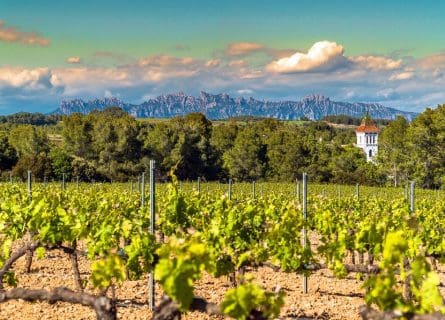
The vast majority of Cava is made in the hills of Sant Sadurní d’Anoia, west of Barcelona. Part of the Alt Penedès subzone of DO Penedès, the vineyards are situated near a confluence of the Averno and Anoia rivers. Flanked by the impressive Montserrat mountain range – home to a famous monastery – the area offers a range of distinct terroirs, with advantageous variations in aspect and altitude. The latter is essential to the local quality equation: Penedès lies on the same latitude as Tuscany. Summer temperatures can, therefore, be very warm – far hotter than would be experienced in Champagne.
Proximity to the sea also contributes to humidity, albeit cooling sea breezes are most welcome in July and August. Nevertheless, without the benefits of diurnal temperature variation (a significant temperature difference between day and night), it would not be easy to produce fresh base wines in this part of Catalunya.
Role of Soil and Grape Varieties
Of course, many producers argue that the magic lies in the soil. Sant Sadurní d’Anoia is blessed with clay and calcareous-loam terroir, with greater volumes of alluvial matter found on the banks of the Anoia River. Rock fragments (slate) are also found on the lower slopes of Montserrat. The three principal varieties—Macabeo, Parellada, and Xarel-lo—are well-suited to the Mediterranean climate and local soils.
However, Chardonnay and Pinot Noir tend to require cooler sites in the highest parts of Catalunya, lest they yield flabby and lackluster base wine. Such is the reality of growing Champagne grapes in a climate where 95°F is part of the course in the summer months.
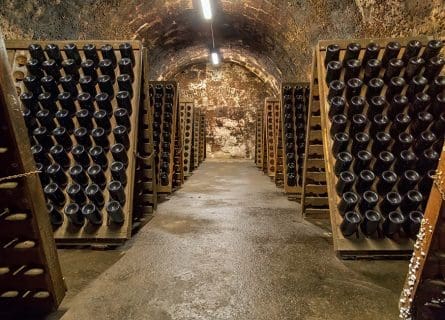
Cava producers spare no effort, time, or expense in making their wine. Indeed, some of the world’s most impressive subterranean cellars are found in Sant Sadurní d’Anoia, particularly in the headquarters of Codorniu and Henkell Freixenet. Only traditional method sparkling wines are produced in these atmospheric caves – Charmat is prohibited under the DO rules. In essence, this involves bottling still wines with the addition of yeast and sugar. A secondary fermentation occurs in the bottle – yeast releases CO2 into the wine as it consumes the sugar.
Once the process is finished, the wine is aged with the dead yeast cells (lees) for a period that ranges from nine months to eight years. Disgorgement (removing yeast sediment from the bottle) will then occur, and the bottle is resealed; a wine/sugar solution called liqueur d’expedition is used to top up wine lost during the disgorgement. It is known as dosage.
However, while the production methods are strictly regulated, Cava is open to many interpretations. Some bodegas refuse to touch international varieties; others value what they bring to the table. Codorniu and Freixenet are pioneers in this regard, producing several high-quality wines based on Chardonnay and Pinot Noir. There are mono-varietal labels and a far greater volume of blends up for grabs – supermarket private labels and prestige cuvées both have a role to play in the DO.
Innovations in Rosé
The vast majority of Cava is dry, although sweeter styles do exist. The quality of Cava Rosados (rosé) has also soared recently. In Champagne, rosé is made by combining red and white wines—the appellation regulations outlaw this. Spanish winemakers, therefore, use the maceration method, extracting a minimum of color from the skins before the juice is run off and the wine is fermented. The best of these are deeply colored, fruit-forward, and very fresh.
According to the DO rules, the minimum aging period on the lees for Cava is nine months – called Cava de Guarda. This produces a charming, youthful sparkling wine that admittedly lacks a strong autolytic character. Meanwhile, Cava de Guarda Superior Reserva wines must be cellared for 18 months before release; the extra depth and yeast impact are more noticeable with Reservas.
Thirty months of storage is the minimum for a Cava de Guarda Superior Gran Reserva; however, the finest examples are aged up to ten years before disgorgement. This allows them to develop a wholly different character, emphasizing autolytic richness over primary fruit. The best Gran Reservas are genuinely exceptional sparkling wines.
Cava de Paraje Calificado
Yet the hierarchy does not stop at Gran Reserva. In 2016, the authorities introduced a new single-vineyard category, Cava de Paraje Calificado. Representing a small (but growing) elite of Spanish bubblies, Paraje Calificado wines are only produced from estate vineyards that are often farmed according to organic principles. They must be aged for at least 36 months before release – many elect to disgorge after 6-7 years. Juve & Camps’ prestige cuvée La Capella represents the cream of the crop: powerfully structured and very complex. Proof indeed that the epithet ‘bargain-basement Champagne’ is both undeserved and incorrect.
You can discover more about Cava here in our – What is Cava? blog post
Cava has been a real talking point for critics and journalists over the past decade. The departure of Raventos I Blanc caused quite a stir at the end of 2012; seven years later, an exodus of nine influential producers sent the DO into panic mode. Fortunately, the appellation’s most important wineries—Codorniu and Freixenet—remain committed to the cause. What Cava is—and its global renown—was entirely built by these two companies.
They have done much to further Cava’s reputation in foreign markets; Codorniu’s Ars Collecta has become one of the appellation’s most successful premium brands. The often-heard criticism that “corporations have destroyed Cava’s image” is just plain wrong.
Nevertheless, historical grievances will be slow to heal. When Raventos I Blanc announced its decision to leave the DO and adopt a regional appellation designation named ‘Conca Del Riu Anoia,’ the response was utter disbelief.
“Historically, the Sant Sadurni Cava industry was always volume- and quality-orientated,” said Pepe Raventos at the time of the announcement. “But today, Cava has become a solely volume-oriented DO with no geographical distinction in terms of climate and soils with low viticultural standards.”
In 2019, Xavier Gramona and eight other wineries followed in his footsteps, creating the new designation Corpinnat after they jumped ship. They argued that it needed to be easier for small, quality-orientated producers to differentiate themselves from the negative connotation of supermarket Cava.
Efforts to Improve Reputation and Quality
Moreover, the appellation framework was historically too liberal for its own good: there were scant vineyard sources or yield rules. In all fairness, however, DO president Javier Pages has done much to atone for past mistakes. The new classification and zoning framework is helping to increase awareness of premium Cava and encourage trade-up from lesser sparkling wines. In the past, growers lacked a formal hierarchy that peaked with single-vineyard Cavas—now they have one. Winemaking and viticulture are improving all the time. Cava is in the ascendant.
Is this enough to bring the family back together again? It’s too early to tell – Gramona and Raventos have not indicated they will abandon Corpinnat and Conca Del Riu Anoia, respectively. Yet without their involvement and resources, all the efforts to promote a better image may reach a plateau; many of Spain’s top winemakers no longer belong to the appellation. Their expertise and cachet, as Pages freely admits, are sorely missed. Still, it will probably take some time before all rifts are healed and unity is restored. “Poco a poco,” as they say in Barcelona.
Chardonnay is a green-skinned grape varietal native to the Burgundy wine region in France and one of the most popular varieties worldwide.
Find out moreDiscover Viura: Rioja's Prominent White Grape & Catalonia's Macabeo. Explore its versatility in exquisite wines. A must-read for wine enthusiasts.
Find out moreUnveil the allure of Parellada grape: a Spanish gem crafting elegant sparkling & white wines. Explore its unique qualities & flavor profile.
Find out moreUnveiling Xarel-lo: A Key Grape in Catalonia's Cava Sparkling Wine. Discover the Intriguing Role of Xarel-lo in Spain's Sparkling Delight.
Find out moreGarnacha: Spain's Red Gem. Akin to Pinot Noir, it bridges terroir and winemaking, crafting captivating expressions.
Find out moreUnveiling Spain's Hidden Gold: Monastrell Wine - Explore the Richness and Allure of this Exceptional Varietal
Find out morePinot noir is a light-bodied red wine varietal closely related to the Vitis vinifera grape and produces the most sought-after red wines in the world.
Find out moreTrepat is a red grape variety native to northeastern Spain, specifically the Catalonia region. It produces light-to-medium-bodied wines with low tannins and high acidity, making them particularly well-suited to sparkling wine production. Trepat is gaining popularity among wine enthusiasts for its unique flavor profile and versatility in winemaking.
The center of high gastronomy in Spain (don’t tell the Basques) is surprisingly democratic in many ways. Almost every bar and cafe will offer tasty snacks throughout the day, ranging from tapas to more substantive raciones and bocadillos (filled rolls). At the other end of the scale, however, you can feast on Catalan chefs’ unrestrained creativity and innovative take on classical dishes. These may include cargols (snails stewed with rabbit and chili), ‘mandonguilles amb sipia’ (meatballs with cuttlefish), and suquet de peix, a delicious fish, potato, and tomato soup.
The only thing that needs to be added is an aperitif. Naturally, you’ll be thrown onto the street if you ask for Champagne! Cava is the only choice here.
Guide to Catalan Gastronomy: Read more

Immerse yourself in Barcelona's vibrant flavors and uncover hidden culinary gems with our expert insider guides. Plan an unforgettable trip today!
Read more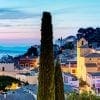
Immerse yourself in Begur's vibrant flavors and uncover hidden culinary gems with our expert insider guides. Plan an unforgettable trip today!
Read more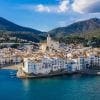
Immerse yourself in Cadaquès's vibrant flavors and uncover hidden culinary gems with our expert insider guides. Plan an unforgettable trip today!
Read more
Immerse yourself in Sitges's vibrant flavors and uncover hidden culinary gems with our expert insider guides. Plan an unforgettable trip today!
Read moreIf you would like us to customize an exclusive luxury tour, contact us and let us know your travel plans. We offer luxury food and wine tours for private groups of a minimum two guests. In addition, all of our private, chauffeured tours are available year-round upon request.

